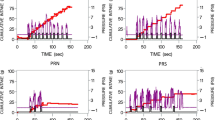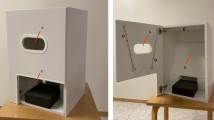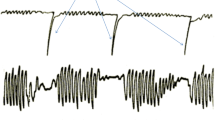Abstract
Our objective was to evaluate a new electronic visual analogue scale (VAS) system for logging subjective motivation to eat ratings. In total, 10 men and 10 women completed both electronic and traditional pen and paper versions of the questionnaire every hour of the waking day. Subjects consumed a standard medium-fat diet, which was fixed at 1.6·BMR. Correlation coefficients for scores obtained by both methods were significant for all questions, with R2 values ranging from 67 to 87%. However, Bland and Altman plots and paired t-tests identified significant bias between the two methods for five of the nine individual questions. These were questions that tended to be scored more towards the ends of the VAS. The new electronic VAS produces comparable, but not interchangeable, results to the traditional pen and paper method in the study of appetite and mood, while offering advantages of improved reliability in data collection.
This is a preview of subscription content, access via your institution
Access options
Subscribe to this journal
Receive 12 print issues and online access
$259.00 per year
only $21.58 per issue
Buy this article
- Purchase on Springer Link
- Instant access to full article PDF
Prices may be subject to local taxes which are calculated during checkout

Similar content being viewed by others
References
Bland JM, Altman DG (1986). Statistical methods for assessing agreement between two methods of clinical measurement. Lancet 8467, 307–310.
Delargy HJ, Lawton CL, Smith FC, King NA, Blundell JE (1996). Electronic appetite rating system (EARS): validation of continuous automated monitoring of motivation to eat [abstract]. Int J Obes Relat Metab Disord 20 (Suppl 4), 104.
Giffin NJ, Ruggiero L, Lipton RB, Silberstein SD, Tvedskov JF, Olesen J et al. (2003). Premonitory symptoms in migraine – an electronic diary study. Neurology 60, 935–940.
Jamison RN, Gracely RH, Raymond SA, Levine JG, Marino B, Herrmann TJ et al. (2002). Comparative study of electronic vs paper VAS ratings: a randomized, crossover trial using healthy volunteers. Pain 99, 341–347.
Jamison RN, Raymond SA, Levine JG, Slawsby EA, Nedeljkovic SS, Katz NP (2001). Electronic diaries for monitoring chronic pain: 1-year validation study. Pain 91, 277–285.
King NA, Lluch A, Stubbs RJ, Blundell JE (1997). High dose exercise does not increase hunger or energy intake in free living males. Eur J Clin Nutr 51, 478–483.
Nishiyama O, Taniguchi H, Kondoh Y, Nishimura K, Suzuki R, Takagi K et al. (2000). The effectiveness of the visual analogue scale 8 in measuring health-related quality of life for COPD patients. Respir Med 94, 1192–1199.
Stratton RJ, Stubbs RJ, Hughes D, King NA, Blundell JE, Elia M (1998). Comparison of the traditional paper visual analogue scale questionnaire with an Apple Newton electronic appetite rating system (EARS) in free living subjects feeding ad libitum. Eur J Clin Nutr 52, 737–741.
Stubbs RJ, Hughes DA, Johnstone AM, Rowley E, Reid C, Elia M et al. (2000). The use of visual analogue scales to assess motivation to eat in human subjects: a review of their reliability and validity with an evaluation of new hand-held computerized systems for temporal tracking of appetite ratings. Br J Nutr 84, 405–415.
Stubbs RJ, Johnstone AM, O’Reilly LM, Barton K, Reid C (1998). The effect of covertly manipulating the energy density of mixed diets on ad libitum food intake in ‘pseudo free-living’ humans. Int J Obes 22, 980–987.
Stubbs RJ, van Wyk MC, Johnstone AM, Harbron CG (1996). Breakfasts high in protein, fat or carbohydrate: effect on within-day appetite and energy balance. Eur J Clin Nutr 50, 409–417.
Acknowledgements
This work was funded by the European Commission, Quality of Life and Management of Living Resources, Key action 1 ‘Food, nutrition and health’ programme (QLK1-2000-00515). We are grateful to Emma Crawford for her assistance in running the study, and to the subjects for their participation. RJS was supported by the Scottish Executive Environment and Rural Affairs Department.
Author information
Authors and Affiliations
Corresponding author
Additional information
Guarantor: S Whybrow.
Contributors: SW conducted the analysis and wrote the manuscript. JRS conducted the study. RJS contributed to the original concept and writing of the manuscript. All authors participated in the interpretation and editing.
Rights and permissions
About this article
Cite this article
Whybrow, S., Stephen, J. & Stubbs, R. The evaluation of an electronic visual analogue scale system for appetite and mood. Eur J Clin Nutr 60, 558–560 (2006). https://doi.org/10.1038/sj.ejcn.1602342
Received:
Revised:
Accepted:
Published:
Issue Date:
DOI: https://doi.org/10.1038/sj.ejcn.1602342
Keywords
This article is cited by
-
Measurement Comparability of Electronic and Paper Administration of Visual Analogue Scales: A Review of Published Studies
Therapeutic Innovation & Regulatory Science (2022)
-
Issues in Measuring and Interpreting Human Appetite (Satiety/Satiation) and Its Contribution to Obesity
Current Obesity Reports (2019)
-
Development of an ecological momentary assessment scale for appetite
BioPsychoSocial Medicine (2015)
-
Validation of a new hand-held electronic data capture method for continuous monitoring of subjective appetite sensations
International Journal of Behavioral Nutrition and Physical Activity (2011)



